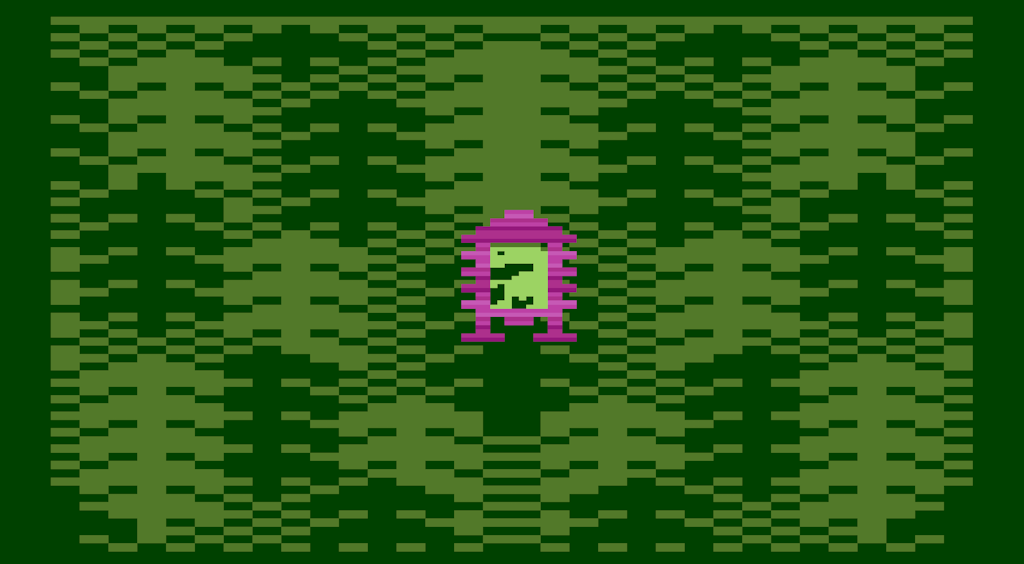
Console Gaming History Adventure: 1982
Well, I did it. It’s been more than three months since my article for 1981, but at long last, I have now played all 459 games for 1982 (285 console games, plus 166 arcade games, plus 8 Game and Watches). And now, it’s time for another article! 😃
1982 is easily the peak year of Generation 2 console gaming. The quality, quantity, and diversity of Gen-2 console games skyrocketed, and this year includes nearly all of the generation’s most famous (and infamous) games! The market was bursting with enthusiasm as countless new players got into the industry with their own games and consoles, and console gaming formally entered the mainstream!
Atari’s lawsuit against Activision concluded this year with a settlement, where Activision agreed to pay royalties to Atari for their unlicensed, third-party titles, and Atari agreed to otherwise leave them alone about it. This settlement effectively green-lighted third-party games for consoles, and this was the major reason for the explosion of available games from all sorts of different companies!
With the maturation of this young industry, existing genres established in arcades in previous years grew in depth and complexity. And for once, much of that innovation was actually happening on the consoles, rather than being limited to arcades! There were just so many fun and interesting ideas! Along with the huge spike in the number of games for this year, 1982 took me so long to finish largely because I was having so much fun, and there was a smaller ratio of the sort of bad, overly complex, uninteresting games that I tend not to want to spend much time on.
Console gaming had truly entered into full-bloom. But like any pretty flower, the beauty was not meant to last. The optimism was much too high, with too many new or previously uninterested companies too eager to throw too much of what they had into the ring. As any professional investor will tell you, that’s a recipe for disaster. The present was bright, sunny, and cheerful, but dark clouds were gathering on the horizon. The happy conditions of 1982 would ultimately lead to the “Great Video Game Crash of 1983”. In retrospect, the signs of trouble were everywhere. But let’s not worry so much about that now, because it will take all the fun out of the greatest year of Generation 2! Let’s just enjoy the moment and immerse ourselves in the happy, starry-eyed optimism of the day as we explore what this very special year had to offer!
New Consoles
1982’s incredible surge of market optimism brought an unbelievable explosion of new consoles to the scene – so many that I struggled to keep track of them all as I went through the games on the list! 😵💫
This newer wave of Generation 2 consoles were far, far more powerful than the older ones. In fact, I would argue they should be considered an entirely separate generation of consoles! Really, they were much closer in their graphical capabilities to Generation 3 consoles such as the NES than they were to the older Generation 2 consoles like the Intellivision or Atari VCS. Plus, the Atari VCS had a successor this year – should both a console and its successor be seen as the same generation?! For these reasons, I like to call the consoles released this year “Generation 2.5” as compared to the older “Generation 2.0” consoles. But that’s my own personal, made-up terminology! 🦇
Whatever way you want to categorize and classify them, here is the amazing lineup for this year:
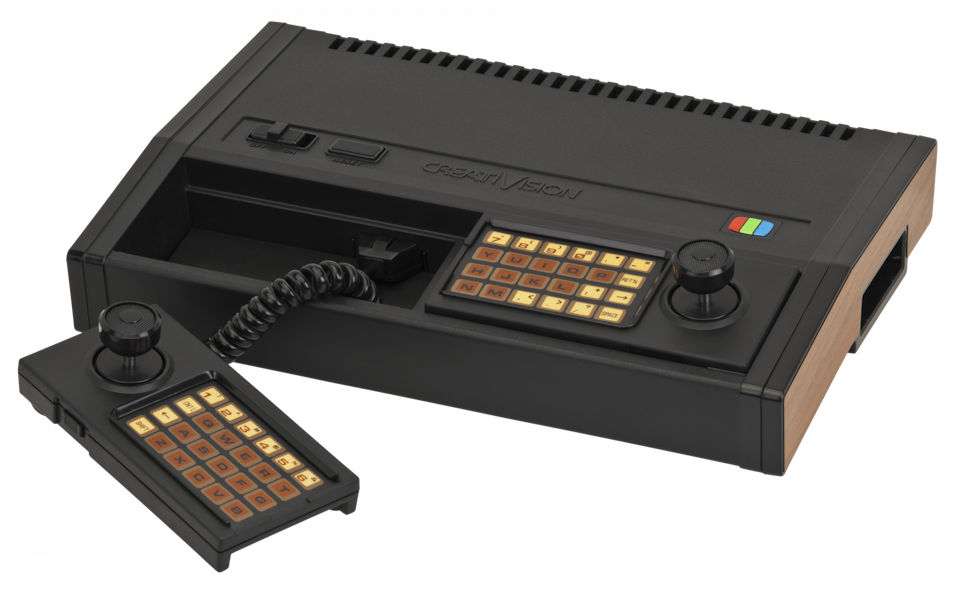 Considered a “hybrid computer and home video game console” by Wikipedia, the VTech CreatiVision and its launch titles were completed in 1981, but they weren’t actually available for sale until early 1982. At first glance, the controllers look like they have the typical nonsense phone key pad design everyone was such a fan of in those days. It’s certainly just as cumbersome and annoying. But I have to admit that it’s pretty cool and clever how each controller is actually half a keyboard, so you have a keyboard to type on if you put both controllers away! The CreatiVision games I have played so far are very advanced, to the point where I’d say it’s the second most graphically beautiful console released this year!
Considered a “hybrid computer and home video game console” by Wikipedia, the VTech CreatiVision and its launch titles were completed in 1981, but they weren’t actually available for sale until early 1982. At first glance, the controllers look like they have the typical nonsense phone key pad design everyone was such a fan of in those days. It’s certainly just as cumbersome and annoying. But I have to admit that it’s pretty cool and clever how each controller is actually half a keyboard, so you have a keyboard to type on if you put both controllers away! The CreatiVision games I have played so far are very advanced, to the point where I’d say it’s the second most graphically beautiful console released this year!
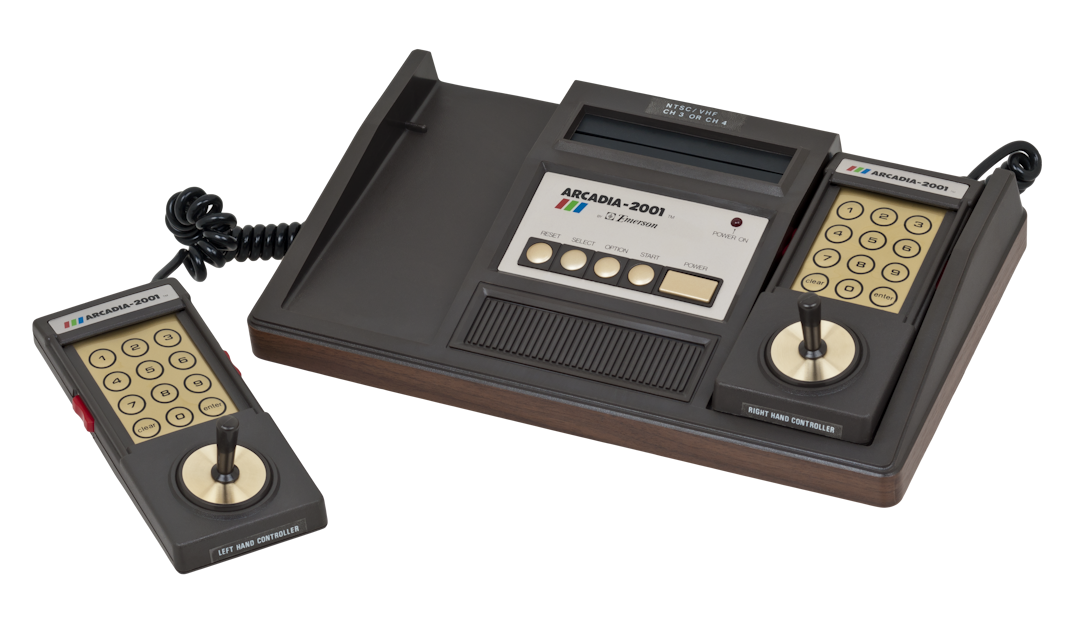 The Emerson Arcadia 2001 was physically smaller and cheaper than other consoles of the time (99USD – or 323.47USD in 2024). Sadly, that came at the cost of performance. The graphics are still about as detailed as the other Gen-2.5 consoles, but the colors are more limited, so that games all tend to have the same garish color scheme. In a way though, it was almost a part of the console’s identity! Seeing the colors of the Arcadia 2001 logo and background on the console certainly makes me think of the games, especially with the way many games had a characteristic solid white background to them. Sadly, the Arcadia 2001’s library of games ultimately didn’t have much meat to it, and combined with its graphical inferiority to its competitors, it was pretty much a failure. It did limp along painfully for another 2 years before finally collapsing, but that’s about the best that can be said for it. 😕
The Emerson Arcadia 2001 was physically smaller and cheaper than other consoles of the time (99USD – or 323.47USD in 2024). Sadly, that came at the cost of performance. The graphics are still about as detailed as the other Gen-2.5 consoles, but the colors are more limited, so that games all tend to have the same garish color scheme. In a way though, it was almost a part of the console’s identity! Seeing the colors of the Arcadia 2001 logo and background on the console certainly makes me think of the games, especially with the way many games had a characteristic solid white background to them. Sadly, the Arcadia 2001’s library of games ultimately didn’t have much meat to it, and combined with its graphical inferiority to its competitors, it was pretty much a failure. It did limp along painfully for another 2 years before finally collapsing, but that’s about the best that can be said for it. 😕
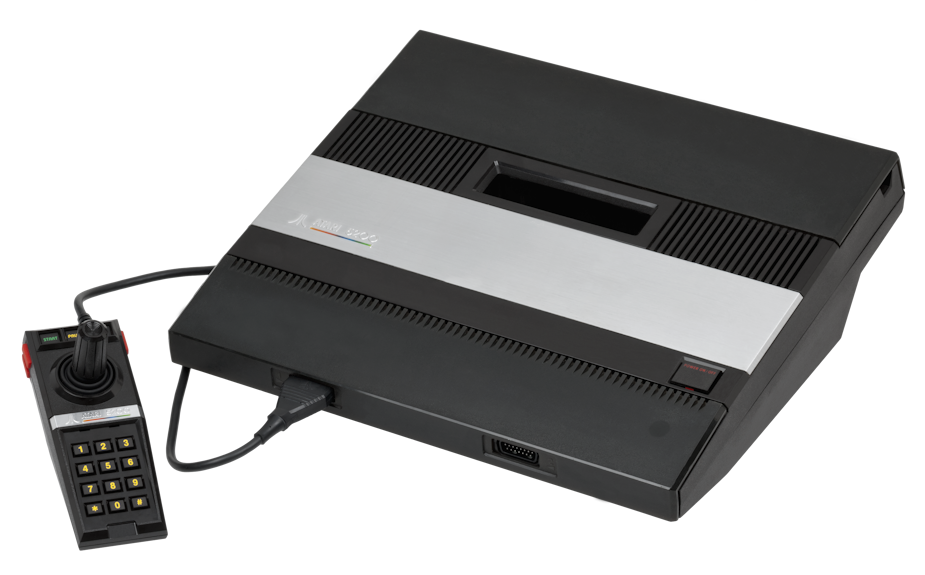 Then we have the legendary – and infamous – Atari 5200! Based on the hardware of Atari’s 8-bit computer line, the 5200 was marketed as the successor to the Atari VCS, which they retroactively renamed the Atari 2600 to differentiate it from the 5200. The idea was that they’d continue to sell the 2600 alongside it for a while as a budget console, but the 5200 was the future.
Then we have the legendary – and infamous – Atari 5200! Based on the hardware of Atari’s 8-bit computer line, the 5200 was marketed as the successor to the Atari VCS, which they retroactively renamed the Atari 2600 to differentiate it from the 5200. The idea was that they’d continue to sell the 2600 alongside it for a while as a budget console, but the 5200 was the future.
Except that it wasn’t. Part of the problem was that it was too expensive when compared with the 2600. It also had a high quality but extremely small library of games. That wouldn’t have been such a problem if it could still play 2600 games, but it couldn’t until much, much later, and by then it was too late.
The biggest issue though was its absolutely miserable controller. I can’t say I’m fond of how they decided to copy the same phone keypad design that was so in fashion at the time, but that’s not really the problem with it. The problem was the joystick on the controller. Amazingly enough, it actually supports full analog movement. It’s a shame almost none of the games do. Meanwhile, the joystick didn’t snap back to the center when you let go of it, making most games nearly unplayable. If that wasn’t bad enough, it was also extremely unreliable and broke easily. Maybe this has something to do with why no one was willing to give analog movement a chance again until the Nintendo 64 more than a decade later. ☹️
Because of its many issues, the Atari 5200 is often considered to be not just a failure, but the worst console ever made. Quite a legacy.
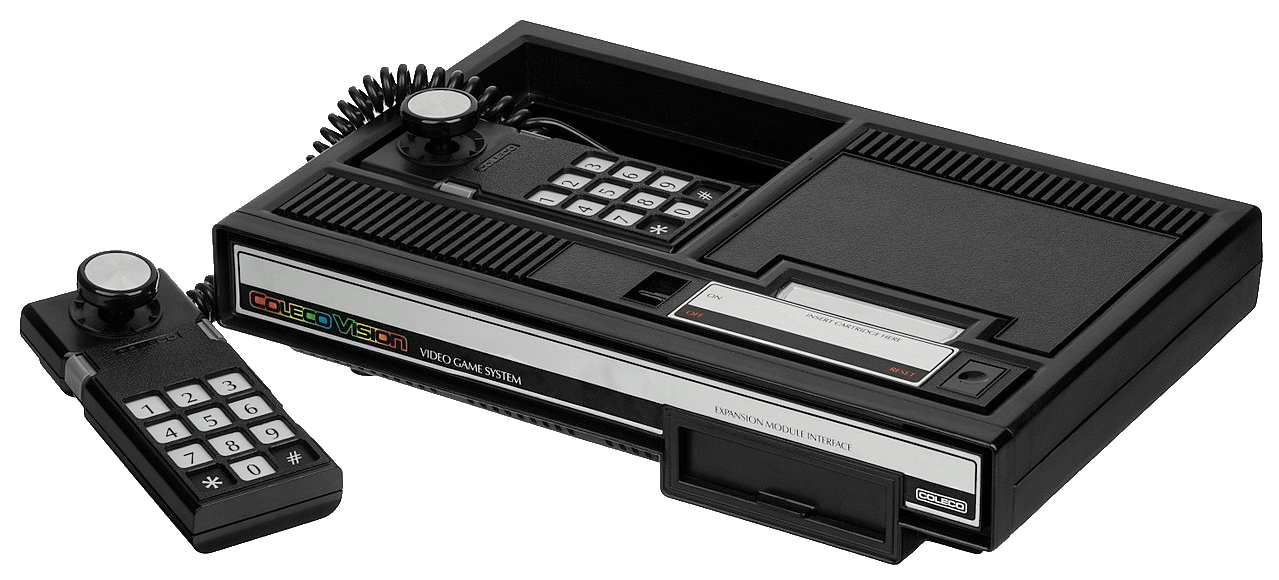 When it comes to raw power, the clear king of Generation 2.5 – and by extension Generation 2 in general – was the Coleco toy company’s ColecoVision console. This thing was capable of powering graphics that looked basically the same as early NES/Famicom games, had identical specs to another Generation 3 console – the Sega SG-1000 – and was close to parity with the average arcade games of the day. People were particularly impressed with public displays of the Smurf launch title for the system, which was easily 1982’s most beautiful video game.
When it comes to raw power, the clear king of Generation 2.5 – and by extension Generation 2 in general – was the Coleco toy company’s ColecoVision console. This thing was capable of powering graphics that looked basically the same as early NES/Famicom games, had identical specs to another Generation 3 console – the Sega SG-1000 – and was close to parity with the average arcade games of the day. People were particularly impressed with public displays of the Smurf launch title for the system, which was easily 1982’s most beautiful video game.
But that’s all about specs, and a console also needs commercial success. The ColecoVision had that too thanks to an incredible deal Coleco made with Nintendo (who did not have their own gaming console at the time), whereby Nintendo gave them the exclusive rights to produce console ports of the famous Donkey Kong arcade game from last year. Coleco used this to create an incredibly close and faithful port of the game for the ColecoVision, and consumers just ate it up! Coleco also had the deviously brilliant idea of porting many of their games, including Donkey Kong, to competing systems, just to show how much worse the games had to look when they weren’t played on a ColecoVision. You’d think they’d make these alternative versions of their games awful on purpose, but they didn’t have to. I’ve played both the ColecoVision and Atari 2600 versions of the games they released this year, and I think the Atari 2600 ports are as good as they could be. It really looks like they tried their honest best to offer the best experience they could for them. And that only made the stark difference between the ColecoVision’s graphics and those of their competitors even more damning!
On top of all that, the ColecoVision beat the Atari 5200 to the punch by actually being able to play Atari 2600 games with the help of a special add-on. Atari responded by suing Coleco. Coleco was forced to pay royalties to Atari as a result of the lawsuit, but the add-on still contributed massively to the ColecoVision’s success in a way that hurt Atari. It made the ColecoVision into a more logical successor than the Atari 5200 for people with existing game collections who wanted to replace their aging Atari 2600 systems with something more modern.
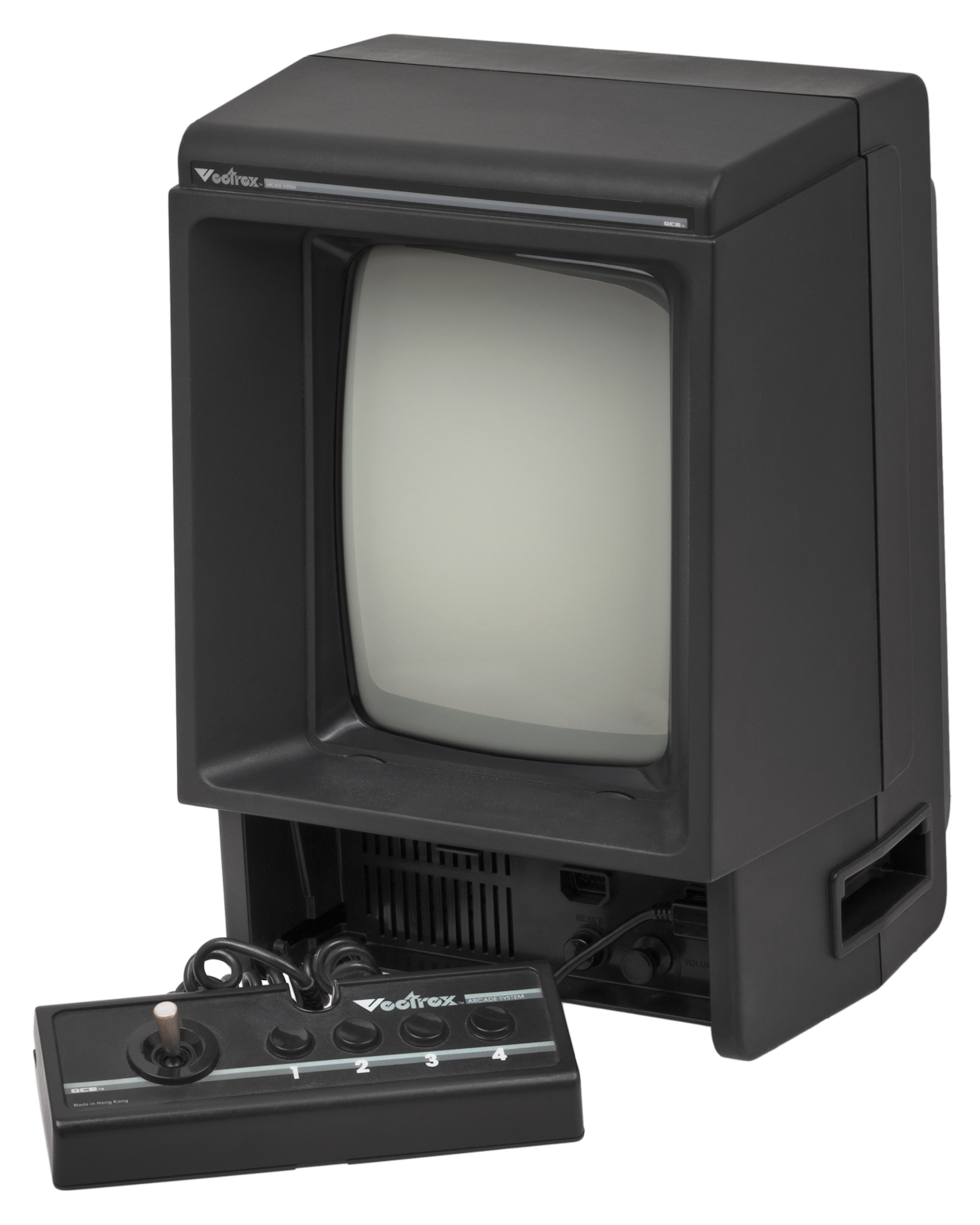 The only other 1982 home console I’ve been able to find is a wonderfully weird product that can’t be compared to anything mentioned above, even when it comes to graphics quality. That’s because General Consumer Electronics’s Vectrex didn’t use conventional graphics, or conventional anything. Rather than being a separate brick you’d put in front of and hook up to your TV, the Vectrex had its own built-in display similar to a modern iMac. That display was geared for vector graphics. Vector graphics are where things are made up of lines and shapes, rather pixels (little squares) like you see with conventional raster graphics. Since vector graphics aren’t made out of pixels, they can scale seamlessly and look good at any size. If you ever played one of those old flash games on the web, they used vector graphics too, and it’s why they looked so sharp no matter how much you zoomed in! Vector graphics had already been used in a number of arcade machines, most famously with Asteroids, but the Vectrex took the technology to your home. Its graphics were limited in that they could only be black and white, and everything had to be drawn as a weird outline, but the tech had its advantages too – several of the titles are actually 3D! To make up for the dullness of monochrome outlines for everything, each Vectrex game came with a translucent overlay to be clipped on the screen that the real graphics would shine through, adding a static colored background to the experience.
The only other 1982 home console I’ve been able to find is a wonderfully weird product that can’t be compared to anything mentioned above, even when it comes to graphics quality. That’s because General Consumer Electronics’s Vectrex didn’t use conventional graphics, or conventional anything. Rather than being a separate brick you’d put in front of and hook up to your TV, the Vectrex had its own built-in display similar to a modern iMac. That display was geared for vector graphics. Vector graphics are where things are made up of lines and shapes, rather pixels (little squares) like you see with conventional raster graphics. Since vector graphics aren’t made out of pixels, they can scale seamlessly and look good at any size. If you ever played one of those old flash games on the web, they used vector graphics too, and it’s why they looked so sharp no matter how much you zoomed in! Vector graphics had already been used in a number of arcade machines, most famously with Asteroids, but the Vectrex took the technology to your home. Its graphics were limited in that they could only be black and white, and everything had to be drawn as a weird outline, but the tech had its advantages too – several of the titles are actually 3D! To make up for the dullness of monochrome outlines for everything, each Vectrex game came with a translucent overlay to be clipped on the screen that the real graphics would shine through, adding a static colored background to the experience.
Even the controller was weird – spurning the fashionable phone keypad controller design of the day for an arcade-like, 4-button slab that almost seemed to anticipate the invention of the gamepad. Like the Atari 5200, the control stick actually supported true analog movement. Once again, very few games were actually coded to take advantage of this analog movement, but at least the control stick was done properly and centered like you’d expect an analog control stick to do.
I think the whole product and its technology is absolutely fascinating, and if I could own only one piece of 20th century hardware, I’d want it to be a Vectrex.
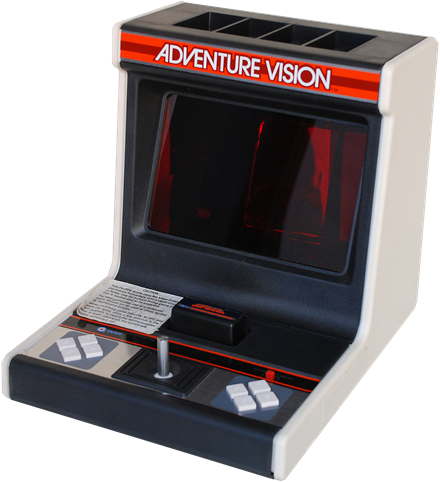 The last console of any kind to talk about is the Entex Adventure Vision released in the later half of the year. Like the Vectrex, the Adventure Vision has its own built-in screen. It’s a portable console – or at least, semiportable. It’s much too big to go in your pocket, but is still much smaller than a full console. It’s designed to be quickly moved from tabletop to tabletop and could run on battery power for a short time before needing to be plugged in again – a bit like a laptop, only with no folding. Sadly even that limited level of portability required huge compromises in system specs. The console’s flickery graphics are monochrome, only being able to show pixels as on (solid red) or off (solid black), with no in-between coloring possible. The 150×40 screen resolution is terrible, and the overall graphical presentation is so limited that it’s almost impossible to tell what you’re doing! Only 4 games were released for this poor little thing, all of which came out the same year. All 4 are just severely downscaled ports of arcade games and don’t offer anything in the way of unique features or gameplay compared to the originals. The Adventure Vision was certainly an interesting idea and I do admire them for braving the odds and giving it a go. But in the end, 1982 was just not the year of portable gaming consoles – the tech just wasn’t there yet. 😕 Dare to dream little guy! 🫡
The last console of any kind to talk about is the Entex Adventure Vision released in the later half of the year. Like the Vectrex, the Adventure Vision has its own built-in screen. It’s a portable console – or at least, semiportable. It’s much too big to go in your pocket, but is still much smaller than a full console. It’s designed to be quickly moved from tabletop to tabletop and could run on battery power for a short time before needing to be plugged in again – a bit like a laptop, only with no folding. Sadly even that limited level of portability required huge compromises in system specs. The console’s flickery graphics are monochrome, only being able to show pixels as on (solid red) or off (solid black), with no in-between coloring possible. The 150×40 screen resolution is terrible, and the overall graphical presentation is so limited that it’s almost impossible to tell what you’re doing! Only 4 games were released for this poor little thing, all of which came out the same year. All 4 are just severely downscaled ports of arcade games and don’t offer anything in the way of unique features or gameplay compared to the originals. The Adventure Vision was certainly an interesting idea and I do admire them for braving the odds and giving it a go. But in the end, 1982 was just not the year of portable gaming consoles – the tech just wasn’t there yet. 😕 Dare to dream little guy! 🫡
Returning Consoles
The Atari VCS, now known as the Atari 2600, continued to have the lion’s share of new releases even though its graphics were now looking even more starkly dated compared to its competitors. Similar to Microsoft Windows today, the Atari 2600 had become the de-facto standard in the market where people owned one because that’s where the games were, and people made games for it because that’s where the customers were. The ColecoVision was only enough to be a serious threat, and it didn’t outright manage to defeat the thing. Even Atari themselves couldn’t crack it with their failed 5200 successor. For the time being, and for a considerable time after, people were all just stuck with it.
The Odyssey² and Intellivision consoles had now been clearly outclassed by the arrival of Generation 2.5, but they managed to continue on in a reasonable form of existence this year, with plenty of new titles. The even more dated and simple, but cheap Cassette Vision console in Japan had a few new games too!
The Bally Computer System continued to be sold by Astrovision this year, who once again renamed the tormented never-was zombie of a console, now calling it the Astrocade. Three new games trickled out as well. Unfortunately, at this point the console’s bad marketing had finally fully squandered what had originally made it so special. While the Astrocade’s graphics were jaw-droppingly amazing for 1978, 1982’s Gen-2.5 consoles easily leapfrogged it. Even the Arcadia 2001 looked clearly better. It wouldn’t be long before this amazing machine that never got the competent marketing it deserved would finally die, with the average gamer of the day having no idea it had ever even existed. So sad. 😞
Noteworthy Games
The number and quality of games improved so much this year that I found myself having to make a lot of hard choices, cutting content to make it fit on a page that you can see still ends up being incredibly long! At least it means that the games I did pick are really worth checking out! Going forward, I think I am going to limit myself to a maximum of 25 games to spotlight like I’ve done this year. Any more and things just start getting silly!
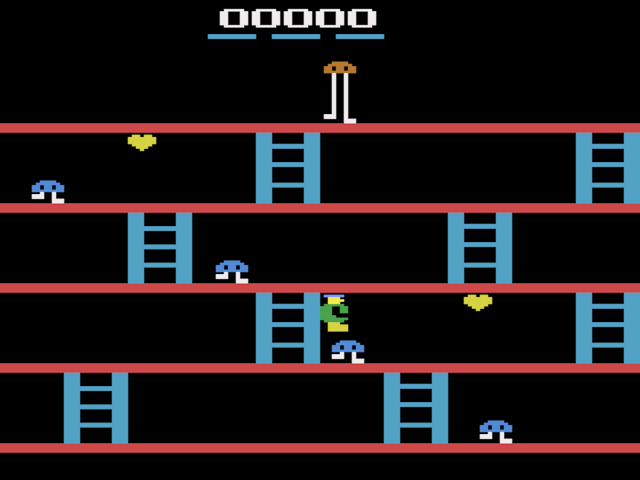 Let’s start off with something nice and simple and straightforward. Back then, platform games didn’t really exist yet. Instead, we had Donkey Kong clones, some of which were straight-up copycats, while others added their own interesting innovations and changes to the concept. Fast Eddie for the Atari 2600 is an example of the latter. You still have ladders and platforms, but instead of falling barrels to jump over, you have these weird little robot things called “sneakers”. Your goal isn’t to make it to the top either – at least, not at first. Instead, you are to jump around, continually switching floors as you climb up and down ladders, trying to catch floating objects that differ in appearance in each level (they are hearts at the start). Once you have collected 9 of them (with an optional 10th for extra score!) a key appears above the tall sneaker at the highest floor, and you can grab the key in order to proceed to the next level. I think it’s fun!
Let’s start off with something nice and simple and straightforward. Back then, platform games didn’t really exist yet. Instead, we had Donkey Kong clones, some of which were straight-up copycats, while others added their own interesting innovations and changes to the concept. Fast Eddie for the Atari 2600 is an example of the latter. You still have ladders and platforms, but instead of falling barrels to jump over, you have these weird little robot things called “sneakers”. Your goal isn’t to make it to the top either – at least, not at first. Instead, you are to jump around, continually switching floors as you climb up and down ladders, trying to catch floating objects that differ in appearance in each level (they are hearts at the start). Once you have collected 9 of them (with an optional 10th for extra score!) a key appears above the tall sneaker at the highest floor, and you can grab the key in order to proceed to the next level. I think it’s fun!
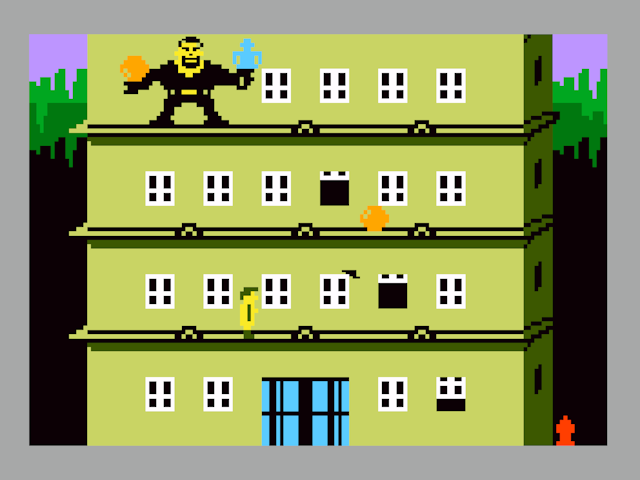 Another example of a game similar to Donkey Kong but with its own creative spin is Beauty and the Beast, which has no relation at all to the famous fairy tale. The game is at least relatively more similar to Donkey Kong than Fast Eddie is. Instead of Donkey Kong, you have “Horrible Hank”, who throws rolling boulders instead of barrels. Horrible Hank has kidnapped a woman named “Tiny Mabel”, and it’s up to her boyfriend, Bashful Buford, to save the day. Just like with Donkey Kong, your mission is to reach the top of the screen, and when you approach Horrible Hank, he gets away with Mabel and you are on to the next screen, climbing a tower. But there are still differences from Donkey Kong that keep the game interesting! Instead of Climbing ladders for example, you climb windows that open and close similar to the arcade game Crazy Climber. While you try to time yourself to be able to climb the windows, you have to watch out for unique and interesting enemies – birds and rats and bats – that try to stop you! Maybe it could have done more to differentiate itself but I thought it was fun and worthwhile as it is. 🤷🏻♀️
Another example of a game similar to Donkey Kong but with its own creative spin is Beauty and the Beast, which has no relation at all to the famous fairy tale. The game is at least relatively more similar to Donkey Kong than Fast Eddie is. Instead of Donkey Kong, you have “Horrible Hank”, who throws rolling boulders instead of barrels. Horrible Hank has kidnapped a woman named “Tiny Mabel”, and it’s up to her boyfriend, Bashful Buford, to save the day. Just like with Donkey Kong, your mission is to reach the top of the screen, and when you approach Horrible Hank, he gets away with Mabel and you are on to the next screen, climbing a tower. But there are still differences from Donkey Kong that keep the game interesting! Instead of Climbing ladders for example, you climb windows that open and close similar to the arcade game Crazy Climber. While you try to time yourself to be able to climb the windows, you have to watch out for unique and interesting enemies – birds and rats and bats – that try to stop you! Maybe it could have done more to differentiate itself but I thought it was fun and worthwhile as it is. 🤷🏻♀️
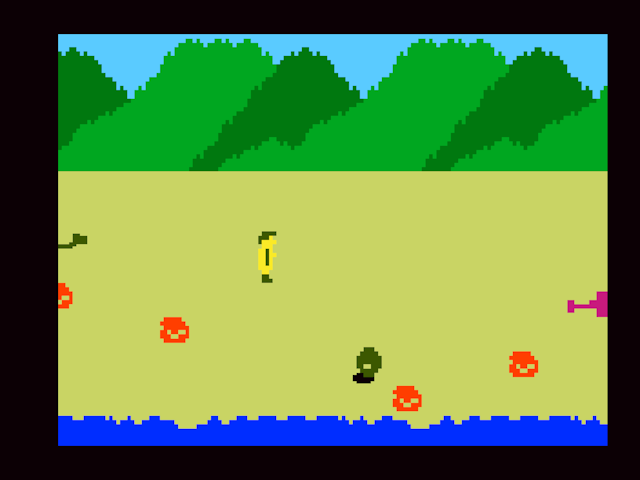 Weirdly, there’s another Intellivision game with an identical looking protagonist in a similar situation, with similar characters, though the names are all different, and the game plays nothing like Beauty and the Beast or Donkey Kong. Tropical Trouble is a very unique concept. It’s a bit like a scrolling shooter only you don’t shoot anything and simply try to avoid tripping over stuff. None of obstacles can hurt you, but they cause you to fall further behind the villain, Beach Bruiser! If you fall too far behind then a snake at the left edge of the screen will get you! Instead, you need to dodge all the stuff everywhere in order to catch up to Beach Bruiser, which will let you proceed to the next area. At the end, you have a fairly easy showdown with Beach Bruiser on a bridge, rescue the girl, and then the game repeats in a harder form indefinitely as you go for the high score. It is certainly an interesting game!
Weirdly, there’s another Intellivision game with an identical looking protagonist in a similar situation, with similar characters, though the names are all different, and the game plays nothing like Beauty and the Beast or Donkey Kong. Tropical Trouble is a very unique concept. It’s a bit like a scrolling shooter only you don’t shoot anything and simply try to avoid tripping over stuff. None of obstacles can hurt you, but they cause you to fall further behind the villain, Beach Bruiser! If you fall too far behind then a snake at the left edge of the screen will get you! Instead, you need to dodge all the stuff everywhere in order to catch up to Beach Bruiser, which will let you proceed to the next area. At the end, you have a fairly easy showdown with Beach Bruiser on a bridge, rescue the girl, and then the game repeats in a harder form indefinitely as you go for the high score. It is certainly an interesting game!
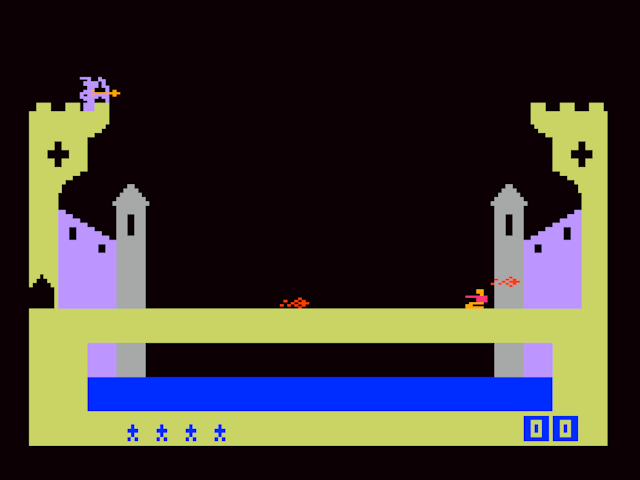 Another more unique game is Dragonfire for the Intellivision and Atari 2600. In Dragonfire, you are a prince, trying to recover treasures from the king’s stolen castle. You have two stages to deal with: The first is a side view outdoors where you jump over and duck under fireballs spewed at you from a dragon inside the castle. On harder difficulties, you also have to deal with all the attention you’ll be getting from an archer on the roof! In the second stage, you are grabbing the treasures from the angry dragon, who tries to kill you with more fireballs. Get the treasures and a door appears that lets you proceed further into another outdoor area, and the cycle repeats as you try and beat your best score. The game can be a bit frustrating at first but it is paced well and gets interesting once you get into it.
Another more unique game is Dragonfire for the Intellivision and Atari 2600. In Dragonfire, you are a prince, trying to recover treasures from the king’s stolen castle. You have two stages to deal with: The first is a side view outdoors where you jump over and duck under fireballs spewed at you from a dragon inside the castle. On harder difficulties, you also have to deal with all the attention you’ll be getting from an archer on the roof! In the second stage, you are grabbing the treasures from the angry dragon, who tries to kill you with more fireballs. Get the treasures and a door appears that lets you proceed further into another outdoor area, and the cycle repeats as you try and beat your best score. The game can be a bit frustrating at first but it is paced well and gets interesting once you get into it.
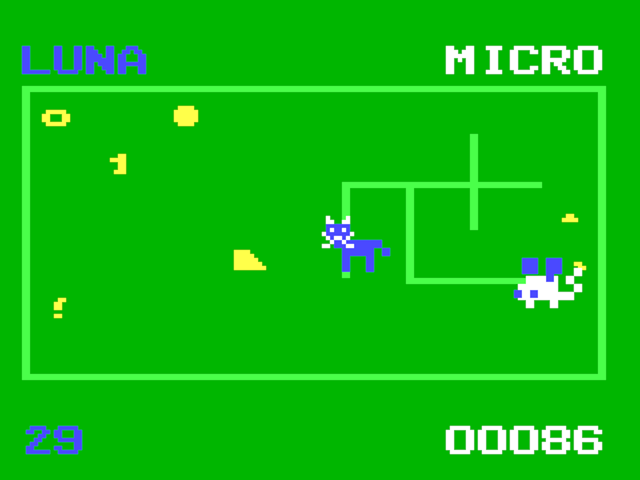 Yet another unique game is The Mousing Cat – one of the few games for the Odyssey² that is actually fun. 😐 You can play the game with either a friend or the computer. Each of you takes turns being the cat or the mouse. When you are the mouse, you have to eat as much cheese on the screen as you can before the cat can trap you. When you are the cat, you have to trap the mouse by holding the controller button to create walls around it. You get score from eating cheese as the mouse, and as the cat you are trying to minimize the amount of cheese your opponent can eat before you manage to trap them. The game is for the most part adorable, though it has a rather nasty animation of the mouse getting eaten at the end of each round. 🫣
Yet another unique game is The Mousing Cat – one of the few games for the Odyssey² that is actually fun. 😐 You can play the game with either a friend or the computer. Each of you takes turns being the cat or the mouse. When you are the mouse, you have to eat as much cheese on the screen as you can before the cat can trap you. When you are the cat, you have to trap the mouse by holding the controller button to create walls around it. You get score from eating cheese as the mouse, and as the cat you are trying to minimize the amount of cheese your opponent can eat before you manage to trap them. The game is for the most part adorable, though it has a rather nasty animation of the mouse getting eaten at the end of each round. 🫣
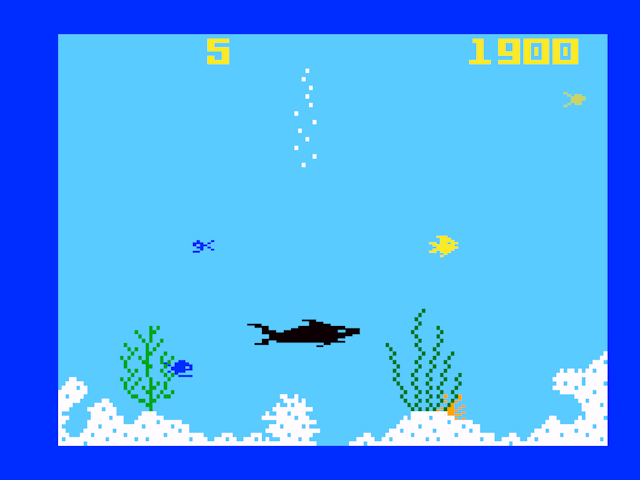 Another game that manages to be super cute in spite of the dark predatory concept is Shark! Shark! for the Intellivision. In Shark! Shark!, you play a little fishy who wants to grow up to be not so little anymore! To do that, you have to go around eating smaller fish by running into them. But be careful! If the fish you run into is bigger than you, you’ll be the one who gets eaten instead! Adding to the fun is a big and scary shark that dominates the festivities. If he gets ahold of you, you are done for, though if you are feeling particularly bold, you can get nips off of his tail!
Another game that manages to be super cute in spite of the dark predatory concept is Shark! Shark! for the Intellivision. In Shark! Shark!, you play a little fishy who wants to grow up to be not so little anymore! To do that, you have to go around eating smaller fish by running into them. But be careful! If the fish you run into is bigger than you, you’ll be the one who gets eaten instead! Adding to the fun is a big and scary shark that dominates the festivities. If he gets ahold of you, you are done for, though if you are feeling particularly bold, you can get nips off of his tail!
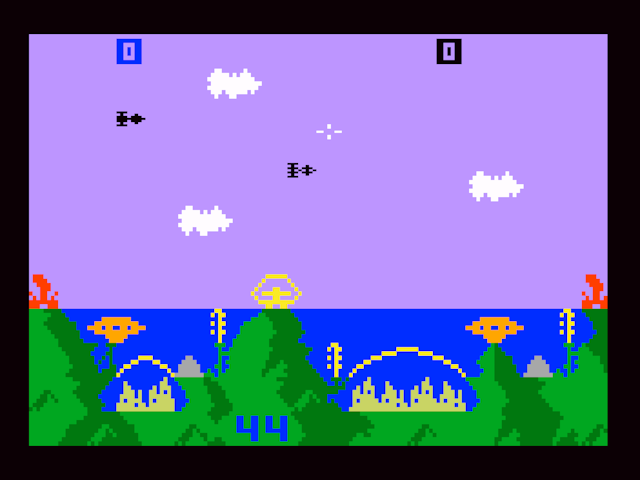 Atlantis for the Intellivision and Atari 2600 (with a port in 1983 for the Odyssey²) combines elements from multiple arcade games into one for an interesting challenge. I personally didn’t care much for it because the concept behind it is just so incredibly dark and depressing without all the cuteness of the last two games, but it was apparently quite popular at the time, so I felt like I had to include it anyway. In Atlantis, you get to see what happened to the lost civilization from the perspective of a person fighting a hopeless battle to defend it from invaders. You need to destroy the enemy aircrafts as they appear on the screen before they have a chance to ruin any of the pretty city! As the game progresses, it gets harder and harder to stop them until all the parts of the poor city are gone, and everyone is dead, and the game ends. 😢
Atlantis for the Intellivision and Atari 2600 (with a port in 1983 for the Odyssey²) combines elements from multiple arcade games into one for an interesting challenge. I personally didn’t care much for it because the concept behind it is just so incredibly dark and depressing without all the cuteness of the last two games, but it was apparently quite popular at the time, so I felt like I had to include it anyway. In Atlantis, you get to see what happened to the lost civilization from the perspective of a person fighting a hopeless battle to defend it from invaders. You need to destroy the enemy aircrafts as they appear on the screen before they have a chance to ruin any of the pretty city! As the game progresses, it gets harder and harder to stop them until all the parts of the poor city are gone, and everyone is dead, and the game ends. 😢
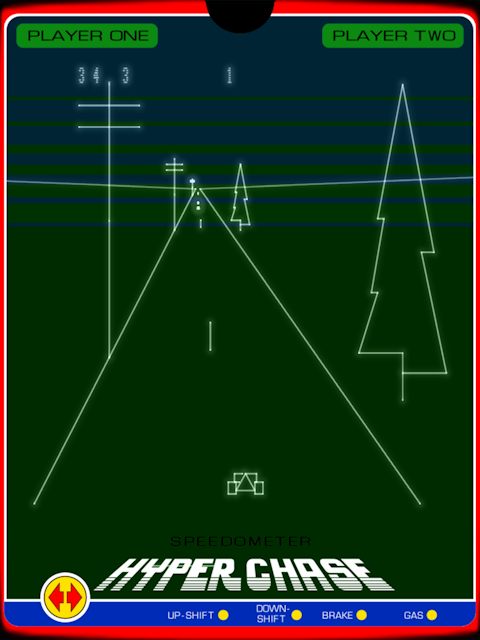 Okay so moving on to happier subjects, there is Hyperchase: Auto Race for the Vectrex. There aren’t many interesting games for the Vectrex but I had to include at least one because the console itself is just so cool! Hyperchase really shows off the console’s capabilities by being a 3D racing game where objects scale smoothly as they get closer to you thanks to the power of the console’s vector graphics.
Okay so moving on to happier subjects, there is Hyperchase: Auto Race for the Vectrex. There aren’t many interesting games for the Vectrex but I had to include at least one because the console itself is just so cool! Hyperchase really shows off the console’s capabilities by being a 3D racing game where objects scale smoothly as they get closer to you thanks to the power of the console’s vector graphics.
Your goal in Hyperchase depends on which of the two game variants you play. In Game 1, your goal is to get through the course in as little time as possible. You can’t run out of lives no matter how many times you crash, but those crashes cost you precious time, so make sure to stay on the road and dodge all the other cars driving on it! In Game 2, you are limited to 5 lives. The goal is to score as many points as possible before you run out through a combination of speed and distance traveled. Neither mode is exceptionally unique or compelling but I think it is interesting to see such elegant 3D in a 1982 home console. For the opportunity to see those graphics alone, I do think this racer is worth a test drive!
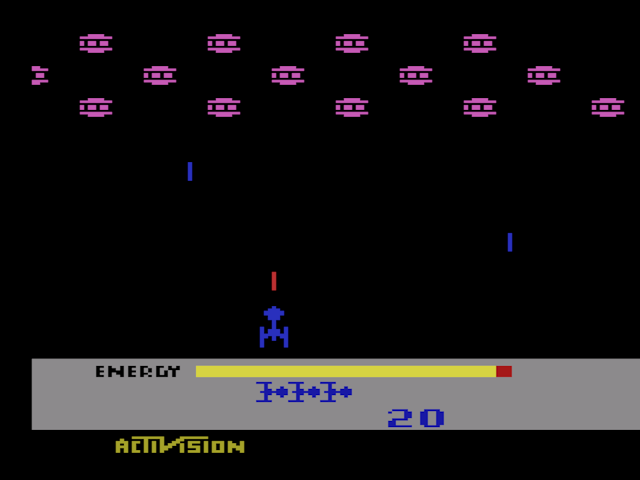 Megamania could be written off as just another generic space shooter like many arcade and console games of the time were it not for its wonderfully bizzare and interesting enemies, including flying deluxe hamburgers, steaming irons, and bow ties. Based on the manual, I think the idea is supposed to be that you are a space pilot having a weird nightmare. I thought it was a cool idea, and the movement patterns of the enemies make for a fun challenge where it takes a lot of practice to advance! The game was apparently ported to and graphically enhanced for the Atari 5200 in 1983.
Megamania could be written off as just another generic space shooter like many arcade and console games of the time were it not for its wonderfully bizzare and interesting enemies, including flying deluxe hamburgers, steaming irons, and bow ties. Based on the manual, I think the idea is supposed to be that you are a space pilot having a weird nightmare. I thought it was a cool idea, and the movement patterns of the enemies make for a fun challenge where it takes a lot of practice to advance! The game was apparently ported to and graphically enhanced for the Atari 5200 in 1983.
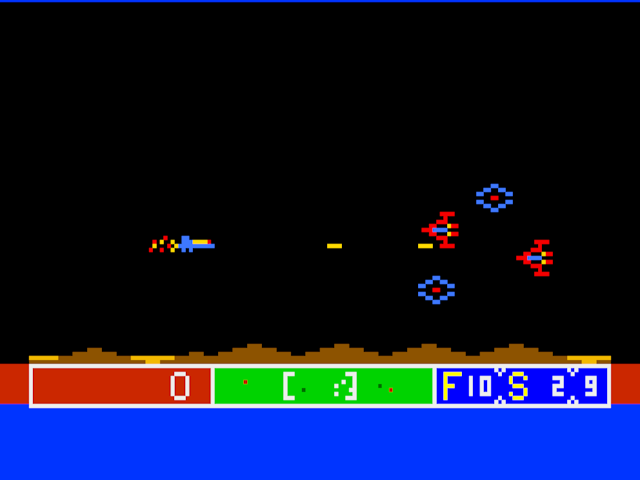 Like with previous years, we also have more straight clones and ports of arcade games. Cosmic Raider for the Astrocade is such a game, based as it is on an arcade game from 1981 called Defender. As with defender, the goal is to use your radar to track down enemies and eliminate them, though unlike Defender, there are no people to rescue during the missions. Instead, you are trying to stop missiles from reaching the ground. I actually like the Astrocade version better than the original because of its easier control scheme for changing the direction of your ship, because of its configurable difficulty, and because stopping missiles is a lot less tedious and frustrating than rescuing the people. The graphics are inferior to the original Defender but in my opinion they still look quite nice for the time! I was happy to see that the Astrocade still has a title worth playing at this point.
Like with previous years, we also have more straight clones and ports of arcade games. Cosmic Raider for the Astrocade is such a game, based as it is on an arcade game from 1981 called Defender. As with defender, the goal is to use your radar to track down enemies and eliminate them, though unlike Defender, there are no people to rescue during the missions. Instead, you are trying to stop missiles from reaching the ground. I actually like the Astrocade version better than the original because of its easier control scheme for changing the direction of your ship, because of its configurable difficulty, and because stopping missiles is a lot less tedious and frustrating than rescuing the people. The graphics are inferior to the original Defender but in my opinion they still look quite nice for the time! I was happy to see that the Astrocade still has a title worth playing at this point.
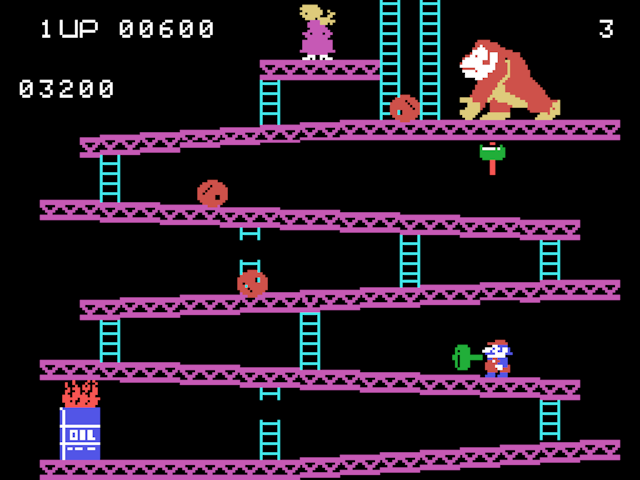 The most famous arcade port of the year though has to be Coleco’s Donkey Kong , which brings the popular arcade game into people’s homes with a shocking level of faithfulness to the original. As you can see from the screenshot, the graphics are only barely worse than they were on the arcade version, and it really showed off the power of the ColecoVision, though they also made a much uglier and simpler port for the Atari 2600. I recommend playing both ports as a way to compare the graphical capabilities of the two systems. The commercial success of the ColecoVision is largely attributed to Coleco’s port of Donkey Kong.
The most famous arcade port of the year though has to be Coleco’s Donkey Kong , which brings the popular arcade game into people’s homes with a shocking level of faithfulness to the original. As you can see from the screenshot, the graphics are only barely worse than they were on the arcade version, and it really showed off the power of the ColecoVision, though they also made a much uglier and simpler port for the Atari 2600. I recommend playing both ports as a way to compare the graphical capabilities of the two systems. The commercial success of the ColecoVision is largely attributed to Coleco’s port of Donkey Kong.
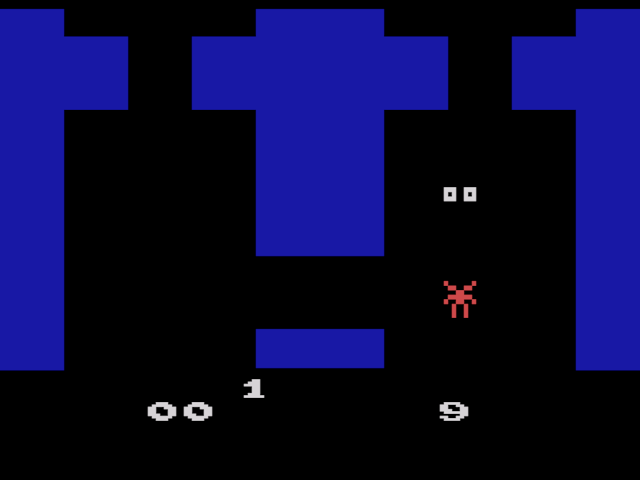 Now here’s where things get a lot more interesting! You really need to check out Haunted House for the Atari 2600! Similar to Superman and Adventure, which we covered in earlier years, Haunted House is a game that can actually be completed! Your mission is to venture into and explore this spooky haunted house, trying to collect the pieces of an urn to bring them back to the exit. The game in many ways anticipates the later concept of survival horror games, and it is certainly quite an experience!
Now here’s where things get a lot more interesting! You really need to check out Haunted House for the Atari 2600! Similar to Superman and Adventure, which we covered in earlier years, Haunted House is a game that can actually be completed! Your mission is to venture into and explore this spooky haunted house, trying to collect the pieces of an urn to bring them back to the exit. The game in many ways anticipates the later concept of survival horror games, and it is certainly quite an experience!
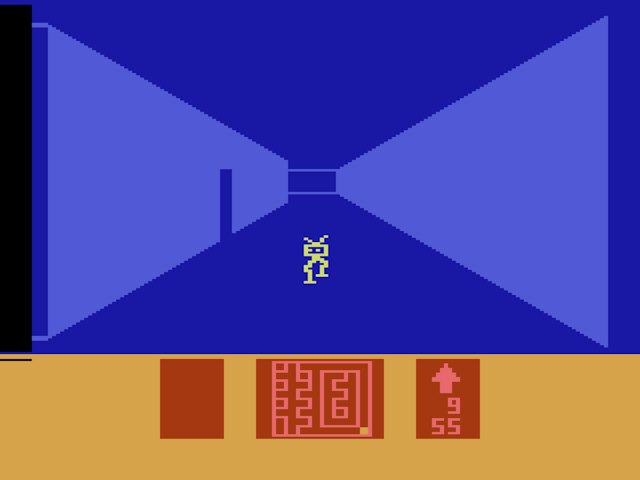 Escape from the Mindmaster for the Atari 2600 is a game that can theoretically be completed too, but you’d have to get really good at it actually make it all the way to the end without running out of lives! The game is shockingly advanced for the time, which is made possible by the fact that it runs through a third-party addon called the “Starpath Supercharger” rather than running on the Atari 2600 directly. The Starpath Supercharger greatly improved the 2600’s available memory, and Escape from the Mindmaster shows what that can mean with a fully 3d maze environment where you find and place differently shaped objects into matching holes on the walls, complete mini games, and advance to the next floor, all while evading the attention of patrolling robots and dodging moving blades coming out of the walls! I had to set up an unlimited lives cheat to make it to the end of the game, but it was quite a fun and satisfying journey. There was also a version of this game for the ColecoVision in development, but it was never released and is only available today online as a prototype.
Escape from the Mindmaster for the Atari 2600 is a game that can theoretically be completed too, but you’d have to get really good at it actually make it all the way to the end without running out of lives! The game is shockingly advanced for the time, which is made possible by the fact that it runs through a third-party addon called the “Starpath Supercharger” rather than running on the Atari 2600 directly. The Starpath Supercharger greatly improved the 2600’s available memory, and Escape from the Mindmaster shows what that can mean with a fully 3d maze environment where you find and place differently shaped objects into matching holes on the walls, complete mini games, and advance to the next floor, all while evading the attention of patrolling robots and dodging moving blades coming out of the walls! I had to set up an unlimited lives cheat to make it to the end of the game, but it was quite a fun and satisfying journey. There was also a version of this game for the ColecoVision in development, but it was never released and is only available today online as a prototype.
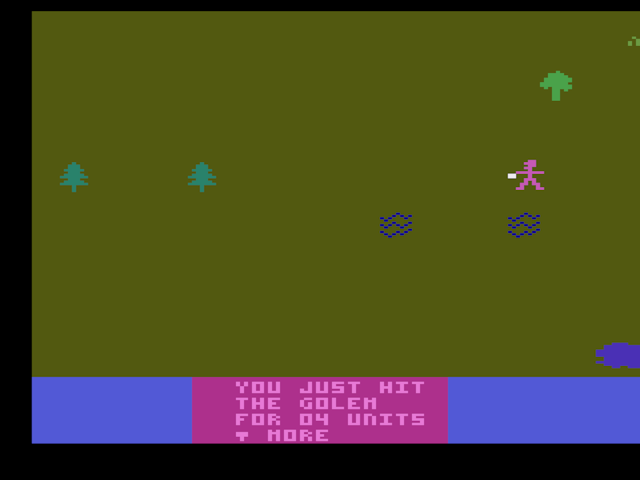 Another completable Starpath Supercharger game that manages to be much more complex than what could otherwise be possible with the Atari 2600 is Dragonstomper. Dragonstomper is far from the first RPG, but it’s the first one in the console gaming world. Even with the help of the Supercharger, making an RPG on the 2600 wasn’t an easy feat, mostly because of the Atari 2600’s very limited single-button controller that made any form of conventional menu navigation impossible. Dragon Stomper works around this through a clever use of the joystick directions to let you make menu selections to check your inventory and other status info. The game consists of three parts. You start off by wandering around in the wilderness grinding and preparing yourself. After getting past a guard, you make it into the village where you can stock up on supplies before entering the 3rd stage – a cavern where you confront an evil dragon that was terrorizing the townsfolk!
Another completable Starpath Supercharger game that manages to be much more complex than what could otherwise be possible with the Atari 2600 is Dragonstomper. Dragonstomper is far from the first RPG, but it’s the first one in the console gaming world. Even with the help of the Supercharger, making an RPG on the 2600 wasn’t an easy feat, mostly because of the Atari 2600’s very limited single-button controller that made any form of conventional menu navigation impossible. Dragon Stomper works around this through a clever use of the joystick directions to let you make menu selections to check your inventory and other status info. The game consists of three parts. You start off by wandering around in the wilderness grinding and preparing yourself. After getting past a guard, you make it into the village where you can stock up on supplies before entering the 3rd stage – a cavern where you confront an evil dragon that was terrorizing the townsfolk!
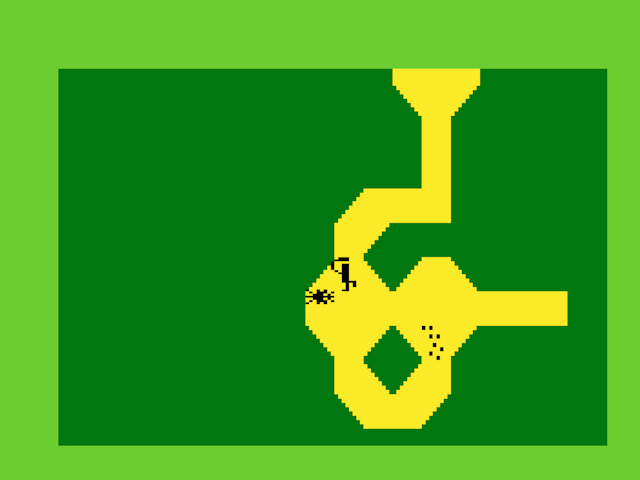 In addition to a more conventional RPG, 1982 saw the console world’s first action RPG as well! Advanced Dungeons and Dragons for the Intellivision is also a completable game, where you must battle a dragon in order to find and reassemble the two broken pieces of a mystical crown. Before you can do that though, you have to get to the evil lair where the crown is held, and to do THAT, you have to explore many dungeons in many mountains, tracking down items along the way that will help you to proceed. The tricky part is that you only have a limited number of arrows with which to defend yourself that can only be replenished by finding more in dungeons, so aim carefully!
In addition to a more conventional RPG, 1982 saw the console world’s first action RPG as well! Advanced Dungeons and Dragons for the Intellivision is also a completable game, where you must battle a dragon in order to find and reassemble the two broken pieces of a mystical crown. Before you can do that though, you have to get to the evil lair where the crown is held, and to do THAT, you have to explore many dungeons in many mountains, tracking down items along the way that will help you to proceed. The tricky part is that you only have a limited number of arrows with which to defend yourself that can only be replenished by finding more in dungeons, so aim carefully!
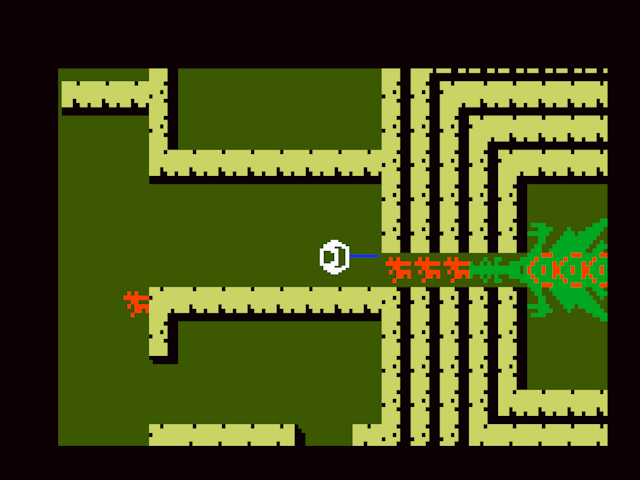 Another fantasy game that should be completable is Swords and Serpents for the Intellivision, but it isn’t completable at all, because it isn’t finished! You heard me – they sold an unfinished game!! In this game, you can play with either 2 players, where Player 1 is the warrior and Player 2 is the wizard, or with 1 player, where you play as the warrior alone (there is no way to play one player with just the wizard). After a long and painful crawl through a difficult dungeon where enemies are constantly materializing around you, you eventually come to the final boss who is – you guessed it – another dragon. I don’t know what it is you humans have against dragons, but I digress. The thing that really makes me mad is that once you make it to the dragon, there isn’t actually a way to beat him and finish the game! Really! I’m not just stuck here – there really isn’t a solution. As shown in the screenshot, the chamber to the dragon is blocked off by a constant stream of impassible flames. If you are playing with single player, you only have the warrior, and this image shows the farthest as you can proceed in the game. If you are playing with two players, you do have the wizard’s wall-destroying spell to get you in there, which is also required to actually collect all the game’s treasures. But even once inside the dragon’s chamber, he doesn’t attack you or respond to you in any way, and there is no way to kill him. Instead the programmer who didn’t finish his work proudly displays his initials and that’s as close to an ending as you are gonna get! Apparently, he ran out of memory on the Intellivision cartridge to complete the game. I really don’t think that’s an excuse. He should have cut other content to make room for something so essential to the experience. I’m lucky I decided to cheat through what is a gruelingly difficult game or I’d be even more disappointed by the lack of an ending. People paid a lot of money for this game and it makes me really mad he would just leave it unfinished like this! 😡
Another fantasy game that should be completable is Swords and Serpents for the Intellivision, but it isn’t completable at all, because it isn’t finished! You heard me – they sold an unfinished game!! In this game, you can play with either 2 players, where Player 1 is the warrior and Player 2 is the wizard, or with 1 player, where you play as the warrior alone (there is no way to play one player with just the wizard). After a long and painful crawl through a difficult dungeon where enemies are constantly materializing around you, you eventually come to the final boss who is – you guessed it – another dragon. I don’t know what it is you humans have against dragons, but I digress. The thing that really makes me mad is that once you make it to the dragon, there isn’t actually a way to beat him and finish the game! Really! I’m not just stuck here – there really isn’t a solution. As shown in the screenshot, the chamber to the dragon is blocked off by a constant stream of impassible flames. If you are playing with single player, you only have the warrior, and this image shows the farthest as you can proceed in the game. If you are playing with two players, you do have the wizard’s wall-destroying spell to get you in there, which is also required to actually collect all the game’s treasures. But even once inside the dragon’s chamber, he doesn’t attack you or respond to you in any way, and there is no way to kill him. Instead the programmer who didn’t finish his work proudly displays his initials and that’s as close to an ending as you are gonna get! Apparently, he ran out of memory on the Intellivision cartridge to complete the game. I really don’t think that’s an excuse. He should have cut other content to make room for something so essential to the experience. I’m lucky I decided to cheat through what is a gruelingly difficult game or I’d be even more disappointed by the lack of an ending. People paid a lot of money for this game and it makes me really mad he would just leave it unfinished like this! 😡
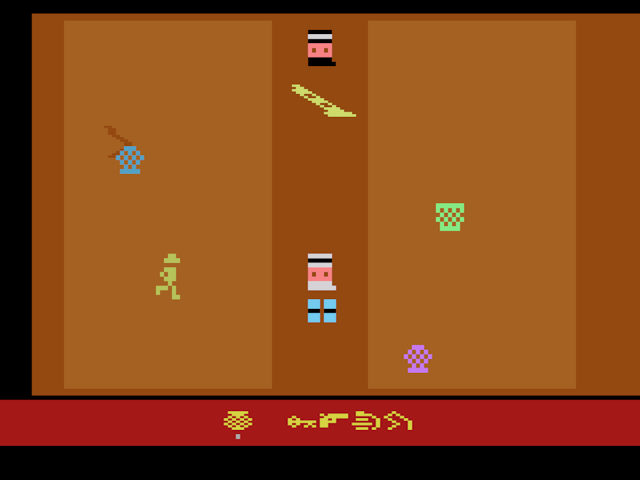 The puzzle adventure game Raiders of the Lost Ark for the Atari 2600 is in theory another completable game, but in practice, it’s so brutally hard and unfair that most people are just not going to be able to do it. The game was quite famous at the time and got really favorable reviews – I think because it had such incredible depth and complexity that was unheard of back in the day. But it accomplished that by pushing the Atari 2600 a lot further than could really be done elegantly. The Atari 2600 joystick’s single button meant that it wasn’t normally possible to do the kind of inventory management the developer wanted for this game, so to get around that, he has it use both controllers – you need to grab the second one to deal with your inventory – which is super-clunky and awkward and has to be done constantly every few seconds during play. The developer also clearly wanted to build a complex, immersive environment, and that isn’t really possible with such limited graphics. When you get stuck on how to progress, 99% of the time it’s related to the fact that you have no idea where you are and what sort of place you are even standing in. You have no idea what the different pixelated blobs on the screen are supposed to be, and that leaves you with no intuitive understanding about how to interact with them. I think people accepted these limitations at the time because you kinda had to if you wanted to play a game like this. But a think the game has aged really, really poorly. Nowadays, if you want to play such an old game, you are not expecting it to be very complicated. And if you want to play something complicated, you are going to want to play it on hardware that can actually handle it and give you a reasonably good experience, because you have that option now and have for decades. All that said, the game has a lot of historical significance, and I do appreciate someone putting in so much effort to take video games to a higher level!
The puzzle adventure game Raiders of the Lost Ark for the Atari 2600 is in theory another completable game, but in practice, it’s so brutally hard and unfair that most people are just not going to be able to do it. The game was quite famous at the time and got really favorable reviews – I think because it had such incredible depth and complexity that was unheard of back in the day. But it accomplished that by pushing the Atari 2600 a lot further than could really be done elegantly. The Atari 2600 joystick’s single button meant that it wasn’t normally possible to do the kind of inventory management the developer wanted for this game, so to get around that, he has it use both controllers – you need to grab the second one to deal with your inventory – which is super-clunky and awkward and has to be done constantly every few seconds during play. The developer also clearly wanted to build a complex, immersive environment, and that isn’t really possible with such limited graphics. When you get stuck on how to progress, 99% of the time it’s related to the fact that you have no idea where you are and what sort of place you are even standing in. You have no idea what the different pixelated blobs on the screen are supposed to be, and that leaves you with no intuitive understanding about how to interact with them. I think people accepted these limitations at the time because you kinda had to if you wanted to play a game like this. But a think the game has aged really, really poorly. Nowadays, if you want to play such an old game, you are not expecting it to be very complicated. And if you want to play something complicated, you are going to want to play it on hardware that can actually handle it and give you a reasonably good experience, because you have that option now and have for decades. All that said, the game has a lot of historical significance, and I do appreciate someone putting in so much effort to take video games to a higher level!
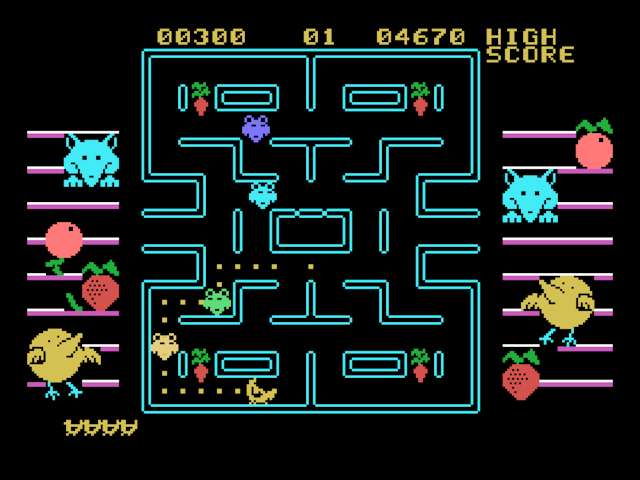 Having played something so creative and innovative, but too far ahead of its time makes me appreciate simpler titles that are a bit too predictable but still manage to offer something clever. Crazy Chicky for the CreatiVision is such a game. For the most part, it’s just a straight clone of Pac-Man, with exactly the kind of gameplay you’d expect. But instead of eating little pellets, you are a chicken that lays eggs, so you are filling the maze of dots rather than emptying it. You do this while running from “funky foxes”, and the different theme has an interesting charm to it! VTech made a variant of Crazy Chicky on a separate cartridge, called Crazy Pucker, that doesn’t have these changes and is essentially just a straight Pac-Man ripoff for CreatiVision users who just wanted a way to scratch their Pac-Man itch. While I’ve always hated how artistic mediums are flooded with works completely lacking in originality, I think it’s important to understand the target audience’s position in this case. Most people couldn’t afford to buy multiple consoles to cover every game they were interested in, and licensing limitations meant console companies often couldn’t offer official ports of the games people who owned their consoles wanted to play, even if those console owners would be otherwise happy to buy them. So that means even very unoriginal games could fill a useful role for customers. So I guess they weren’t a complete waste of time and resources like yet another Spider-Man movie is today. 😣
Having played something so creative and innovative, but too far ahead of its time makes me appreciate simpler titles that are a bit too predictable but still manage to offer something clever. Crazy Chicky for the CreatiVision is such a game. For the most part, it’s just a straight clone of Pac-Man, with exactly the kind of gameplay you’d expect. But instead of eating little pellets, you are a chicken that lays eggs, so you are filling the maze of dots rather than emptying it. You do this while running from “funky foxes”, and the different theme has an interesting charm to it! VTech made a variant of Crazy Chicky on a separate cartridge, called Crazy Pucker, that doesn’t have these changes and is essentially just a straight Pac-Man ripoff for CreatiVision users who just wanted a way to scratch their Pac-Man itch. While I’ve always hated how artistic mediums are flooded with works completely lacking in originality, I think it’s important to understand the target audience’s position in this case. Most people couldn’t afford to buy multiple consoles to cover every game they were interested in, and licensing limitations meant console companies often couldn’t offer official ports of the games people who owned their consoles wanted to play, even if those console owners would be otherwise happy to buy them. So that means even very unoriginal games could fill a useful role for customers. So I guess they weren’t a complete waste of time and resources like yet another Spider-Man movie is today. 😣
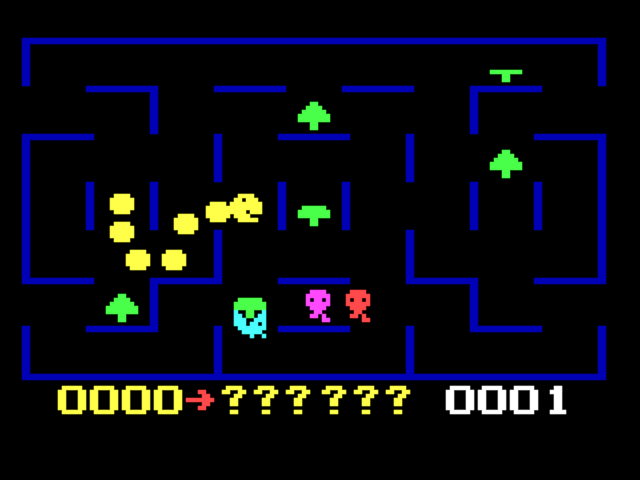 But if these clones are useful to console makers and their users, are they actually legal? That’s what was tested with the K.C. Munchkin series for the Odyssey². It was Atari that had exclusive rights to make a console version of Pac-Man, and they decided to sue Philips for the first K.C. game from 1981 on the basis that it was a Pac-Man ripoff, ultimately successfully managing to block sales of the game. I think that was a pretty unfair outcome for Philips because countless other people were making Pac-Man ripoffs, K.C. Munchkin was one of the most innovative of these rip-offs, and it was only them who got punished for it! ☹️ Even so, Philips learned from the experience when they made the 1982 sequel that continued K.C. Munchkin’s adventures, called K.C.’s Crazy Chase. In this new game, Philips has taken extreme steps to further differentiate things from Pac-Man. The original game had sparse, moving pellets in the maze, but Crazy Chase does away with the concept of pellets entirely, replacing them with large, edible plants that you are stuck on for critical seconds when you munch them to add to the challenge. There’s also this growing snake thing slithering around the maze and eating the plants too to grow longer. The plants regrow continually, so to finish the level you have to eat up the snake’s body rather than the plants. At least Philips’s unfair treatment lead to something creative happening that otherwise wouldn’t have!
But if these clones are useful to console makers and their users, are they actually legal? That’s what was tested with the K.C. Munchkin series for the Odyssey². It was Atari that had exclusive rights to make a console version of Pac-Man, and they decided to sue Philips for the first K.C. game from 1981 on the basis that it was a Pac-Man ripoff, ultimately successfully managing to block sales of the game. I think that was a pretty unfair outcome for Philips because countless other people were making Pac-Man ripoffs, K.C. Munchkin was one of the most innovative of these rip-offs, and it was only them who got punished for it! ☹️ Even so, Philips learned from the experience when they made the 1982 sequel that continued K.C. Munchkin’s adventures, called K.C.’s Crazy Chase. In this new game, Philips has taken extreme steps to further differentiate things from Pac-Man. The original game had sparse, moving pellets in the maze, but Crazy Chase does away with the concept of pellets entirely, replacing them with large, edible plants that you are stuck on for critical seconds when you munch them to add to the challenge. There’s also this growing snake thing slithering around the maze and eating the plants too to grow longer. The plants regrow continually, so to finish the level you have to eat up the snake’s body rather than the plants. At least Philips’s unfair treatment lead to something creative happening that otherwise wouldn’t have!
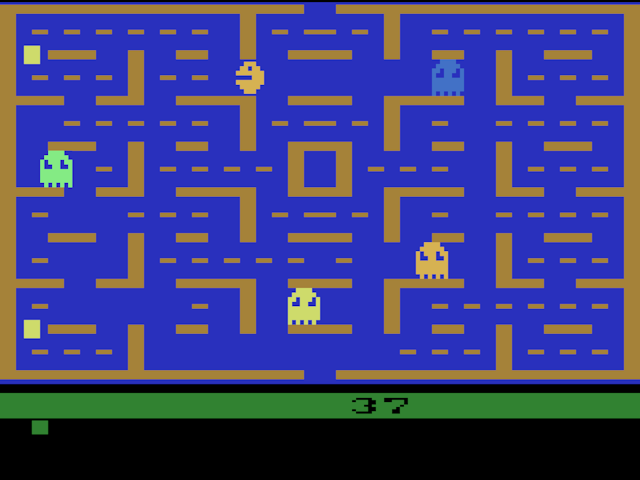 So if Atari had the exclusive rights to make a console port of Pac-Man, what did they do with those rights other than sue people? Produce garbage! Atari’s Pac-Man for the Atari 2600 is infamous for being a deeply flawed and limited port of Pac-Man. The ghosts have no AI and just move randomly around the maze. The game deals with the limitations to on-screen sprites per frame by having all four ghosts flicker badly so that each frame has only one ghost visible. This makes it hard to tell where the ghosts actually are in the maze, makes the game look really ugly, and made getting a screenshot for this article a serious pain. 😩 Other than the ghosts and Pac-Man himself, all graphics are just featureless rectangles with identical coloring. Critics also loathed the unfaithfully blue background, which was the result of a strange policy by Atari at the time that no game could have a black background unless the game took place in outer space.
So if Atari had the exclusive rights to make a console port of Pac-Man, what did they do with those rights other than sue people? Produce garbage! Atari’s Pac-Man for the Atari 2600 is infamous for being a deeply flawed and limited port of Pac-Man. The ghosts have no AI and just move randomly around the maze. The game deals with the limitations to on-screen sprites per frame by having all four ghosts flicker badly so that each frame has only one ghost visible. This makes it hard to tell where the ghosts actually are in the maze, makes the game look really ugly, and made getting a screenshot for this article a serious pain. 😩 Other than the ghosts and Pac-Man himself, all graphics are just featureless rectangles with identical coloring. Critics also loathed the unfaithfully blue background, which was the result of a strange policy by Atari at the time that no game could have a black background unless the game took place in outer space.
While the critical reception for the Pac-Man port was so scathing, consumers seemed desperate enough for the chance to play Pac-Man at home that they put up with the problems. Pac-Man became the best selling Atari 2600 game of all time and was a big commercial success for the company, but it came at a grave cost to the company’s reputation that would come back to bite them later. In later years, this port would be seen as one of the major reasons for the Great Video Game crash of 1983 for helping to destroy consumer confidence in video game quality in general.
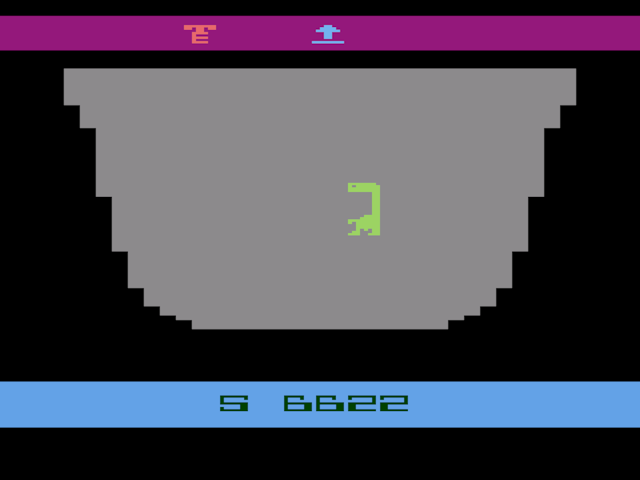 Since obtaining the rights to a popular franchise and selling a terrible quality game with it had worked out for their pocketbooks so well last time, Atari decided to push their luck again with E.T. the Extra Terrestrial for the Atari 2600. They forced an otherwise competent and reputable game developer (the same guy who made the Raiders of the Lost Ark game) to produce rushed tripe in order to get the thing out in time for the Christmas shopping season. Just like the Pac-Man port, consumers were excited enough by the E.T. intellectual property that they were very eager to buy the game, and sales were phenomenal!
Since obtaining the rights to a popular franchise and selling a terrible quality game with it had worked out for their pocketbooks so well last time, Atari decided to push their luck again with E.T. the Extra Terrestrial for the Atari 2600. They forced an otherwise competent and reputable game developer (the same guy who made the Raiders of the Lost Ark game) to produce rushed tripe in order to get the thing out in time for the Christmas shopping season. Just like the Pac-Man port, consumers were excited enough by the E.T. intellectual property that they were very eager to buy the game, and sales were phenomenal!
But while the terrible Pac-Man port had at least been based on a critically acclaimed game that people were attached to, E.T. wasn’t originally a game and so it didn’t have that advantage. The gameplay was fundamentally slow-paced, clunky, confusing, tedious, frustrating, and just plain awful. It involved just wandering around trying to find phone parts buried in numerous pits that were difficult to get out of, and enemies that would drag you around the map to make you lose track of all the pits you’d checked. The severe limitation of the Atari controller’s single button was dealt with by having it perform a completely different function based on the exact spot on the map you were standing, which meant you’d be desperately fishing around for the right arbitrary place to stand to be able to do something. Since high scores were based on how quickly you could finish, and since how quickly you could finish was based heavily on random chance, it left people with nothing to do once the short game had been completed.
People might have bought a lot of copies, but keeping them was a different story. Nearly every E.T. cartridge that Atari sold was ultimately returned for a refund, damaging their reputation further and causing severe harm to the retail stores that sold the game as well. Like Atari’s Pac-Man, Atari’s E.T. the Extra Terrestrial has since been viewed as a major contributer to the 1983 video game crash. It’s even widely considered to be the worst video game ever made! And that’s of course a great reason to try playing it! 😃
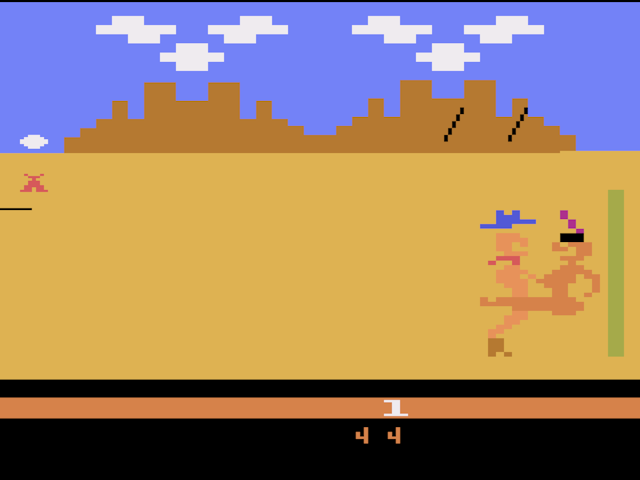 Another fascinating train wreck of the time to gawk at is Custer’s Revenge for the Atari 2600, brought to us by a porn-themed video game company called PlayAround. If E.T. the Extra Terrestrial is the worst video game ever produced, Custer’s Revenge is quite possibly the most tasteless and offensive. Now I realize that the competition is pretty stiff there! But I’m telling you – none of the contenders are anywhere near as “stiff” as General George Armstrong Custer, an actual historical figure who is out to get revenge for his defeat at the hands of Native Americans in the 1876 Battle of Little Bighorn. He does this by coming back to life and copulating with a Native American woman tied to a pole, presumably to contaminate their gene pool with his White genetics as the rest of the tribe desperately tries to stop him. At least the woman doesn’t seem to mind it too much.
Another fascinating train wreck of the time to gawk at is Custer’s Revenge for the Atari 2600, brought to us by a porn-themed video game company called PlayAround. If E.T. the Extra Terrestrial is the worst video game ever produced, Custer’s Revenge is quite possibly the most tasteless and offensive. Now I realize that the competition is pretty stiff there! But I’m telling you – none of the contenders are anywhere near as “stiff” as General George Armstrong Custer, an actual historical figure who is out to get revenge for his defeat at the hands of Native Americans in the 1876 Battle of Little Bighorn. He does this by coming back to life and copulating with a Native American woman tied to a pole, presumably to contaminate their gene pool with his White genetics as the rest of the tribe desperately tries to stop him. At least the woman doesn’t seem to mind it too much.
Even in the early 1980s, where people were far less sensitive about this kind of thing than they are today, Custer’s Revenge managed to generate a lot of outrage from women’s right’s groups, Native American rights advocates, and pretty much everyone else. While nobody else seems to take note, I also think it’s in poor taste to involve an actual real person in a porn-themed game without their consent, even where that person is long dead. 😬 Predictably though, all the outrage only served to improve the game’s publicity and generate more sales, which was probably the idea to begin with. And I’m being perfectly honest, learning about this whole debacle did manage to make me laugh pretty hard. As with all their games, PlayAround eventually made a gender-reversed version of Custer’s Revenge for the ladies, called General Re-Treat, which was released in 1983 and instead has General Custer tied to a pole and the Native American woman pouncing on him!
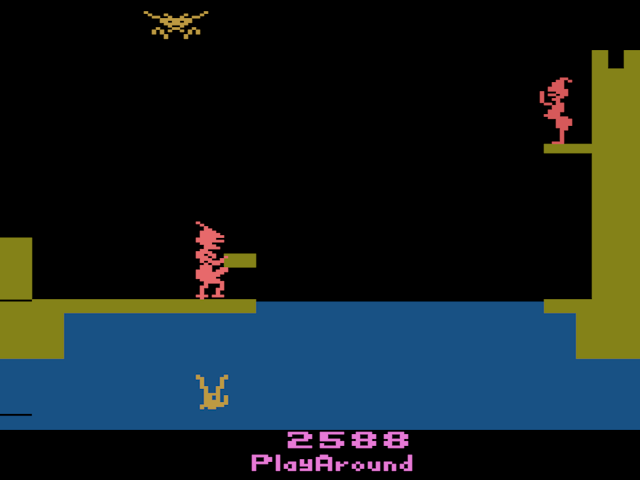 Most of PlayAround’s games were nearly as awful, but one I thought was actually quite clever, funny, and overall very well done for what it is is Knight on the Town, also for the Atari 2600. In this game, you are a brave and noble knight who, as the manual puts it, “is NOT in shining armor”. There is a rather curvaceous… er… I mean “fair” maiden who is very interested in what she can plainly see you have to offer. The problem is that she’s trapped in a castle across a moat of water! So you are building a bridge in order to reach her by picking up blocks from a stack and placing them down over the water. There to make things difficult for you are several monsters, most notably a hungry crocodile that will bite your peenie off in an elaborate animation if you fall into the water! You have infinite lives, so with enough patience you will always be able to eventually reach the girl in the castle no matter how bad you are at video games. But while you have a lot of feelings running through you at the moment, patience is not one of them, so your goal is to get to her in the best time possible! The developer does an especially good job with the animations of the knight, making him move and bounce in just the right way to create an extremely lewd display even under such extreme graphical constraints. At the very least, I can say it was certainly one of the more interesting and memorable things I’ve encountered with this whole gaming project!
Most of PlayAround’s games were nearly as awful, but one I thought was actually quite clever, funny, and overall very well done for what it is is Knight on the Town, also for the Atari 2600. In this game, you are a brave and noble knight who, as the manual puts it, “is NOT in shining armor”. There is a rather curvaceous… er… I mean “fair” maiden who is very interested in what she can plainly see you have to offer. The problem is that she’s trapped in a castle across a moat of water! So you are building a bridge in order to reach her by picking up blocks from a stack and placing them down over the water. There to make things difficult for you are several monsters, most notably a hungry crocodile that will bite your peenie off in an elaborate animation if you fall into the water! You have infinite lives, so with enough patience you will always be able to eventually reach the girl in the castle no matter how bad you are at video games. But while you have a lot of feelings running through you at the moment, patience is not one of them, so your goal is to get to her in the best time possible! The developer does an especially good job with the animations of the knight, making him move and bounce in just the right way to create an extremely lewd display even under such extreme graphical constraints. At the very least, I can say it was certainly one of the more interesting and memorable things I’ve encountered with this whole gaming project!
Knight on the Town’s gender-reversed version, released the same year, is called Lady in Wading, where you are instead a brave and noble dame – also not in shining armor – after a well endow… I mean handsome prince! But it’s still up to you to be the one to do the work and take the risk of building the bridge in order to earn his… um… affection as he waits helplessly for your “rescue”. At least the gender-reversed versions of these games, being otherwise identical counterparts, really help to avoid unfortunate implications about how a straight person’s sexuality is required to work based on their gender, something I think is almost as much of a problem today as it was back then. In that way, I think these games are ironically actually pretty progressive. There are no male gay or lesbian versions of the games though.
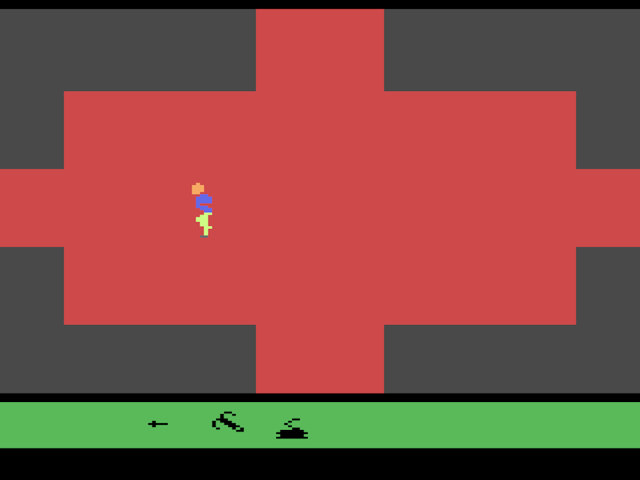 While Knight on the Town and Custer’s Revenge might leave people “at attention” in their own special way, I would say that Swordquest is by far the most interesting concept that video games brought us in 1982, or even that video games brought us ever! The series kicks off with Swordquest: Earthworld, with the other installments to come later. The series was to consist of 4 games, named after each of the original 4 elements of Western culture: Earth, Fire, Water, and Air. They were not actually very good games, but that wasn’t the point. For you see, these four games were all about seeking treasure – treasure that was real!
While Knight on the Town and Custer’s Revenge might leave people “at attention” in their own special way, I would say that Swordquest is by far the most interesting concept that video games brought us in 1982, or even that video games brought us ever! The series kicks off with Swordquest: Earthworld, with the other installments to come later. The series was to consist of 4 games, named after each of the original 4 elements of Western culture: Earth, Fire, Water, and Air. They were not actually very good games, but that wasn’t the point. For you see, these four games were all about seeking treasure – treasure that was real!
The games themselves, and the full-blown comic books that were included with them, were about seeking clues that would leave you eligible for a real-life contest where you could win one of the games’ items. Swordquest: Earthworld was to involve seeking the “Talisman of Penultimate Truth”, Swordquest: Fireworld was to involve seeking the “Chalice of Light”, Swordquest: Waterworld was to involve seeking the “Crown of Life”, and finally, Swordquest: Airworld was to involve seeking the “Philosopher’s Stone”. The four winners of these four items were to have competed for a fifth, called “The Sword of Ultimate Sorcery”. These sacred artifacts were not cheap plastic trinkets like what you would get out of a cereal box – oh no no! They were of real value, made of actual precious metals and gems, blurring the line between fantasy and reality in a most exciting way!
Unfortunately, this amazing project didn’t work out, thanks to the Great Video Game Crash of 1983. Swordquest: Earthworld and 1983’s Swordquest: Fireworld were the only ones that went as planned, with the Talisman and Chalice awarded to the brave adventurers who had earned them. By the time Swordquest: Waterworld came out, Atari’s financial problems due to the sagging gaming market meant they only held the contest at all to avoid legal issues, and just made it about awarding people some money. As for Swordquest: Airworld, the game was only 40% complete by the time the overall project collapsed, and the unfinished prototype has never been found.
We know that all 5 treasures were actually made, so the question remains, what became of them? We know that the hero who won the Talisman of Penultimate Truth melted it down in order to buy a car. 😢 The Chalice of Light was treated with more love, and as of 2024 remains in the hands of its winner, who plans to pass it down as a family heirloom. As for the other three, great legends abound of what ultimately became of them, but though many an adventure has quested for their whereabouts, none of the three have ever been found. The most likely outcome is that they were returned to the mint that made them, who would have melted and dismantled the materials for use in other projects. But because that’s never been confirmed, the dream, and the magic, survives!
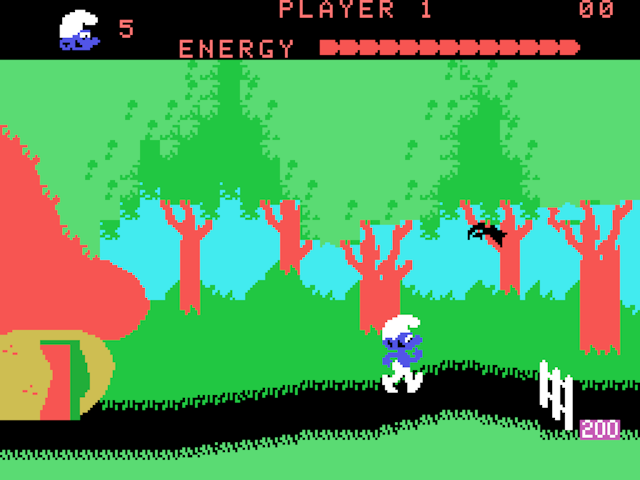 Whatever may be said about colossal complexity, elegant simplicity, ground-breaking innovation, facepalming stupidity, or shocking, hilarious tastlessness, when it comes purely to simple eye candy, Smurf: Rescue in Gargamel’s Castle for the ColecoVision is the clear and indisputable winner of 1982 console gaming. The game’s visuals are colorful, cheerful, and beautiful, looking more like a NES game than something you’d expect to find in this era outside of arcades.
Whatever may be said about colossal complexity, elegant simplicity, ground-breaking innovation, facepalming stupidity, or shocking, hilarious tastlessness, when it comes purely to simple eye candy, Smurf: Rescue in Gargamel’s Castle for the ColecoVision is the clear and indisputable winner of 1982 console gaming. The game’s visuals are colorful, cheerful, and beautiful, looking more like a NES game than something you’d expect to find in this era outside of arcades.
As for the gameplay, it isn’t terrible – at least if you play on the easier difficulties. You have to just walk to the right, making correctly timed jumps over obstacles, with a sinking energy bar preventing you from stopping for too long. At higher difficulties though, you have to deal with enemies, where you have to time how you move past them without waiting so long that you can no longer finish the area before you run out of energy. This can be extremely frustrating.
Meanwhile, in Arcade Land…
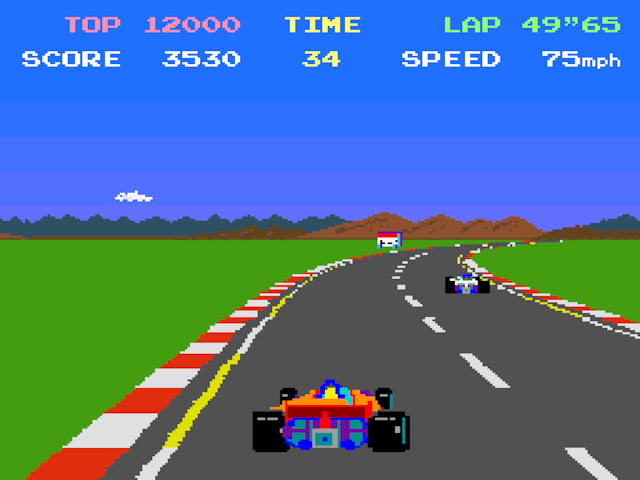 This is the first year where there are actually more console games to play than arcade games! But there were still plenty of arcade games too, and they continued to mature and advance. Their 8-bit graphics once again look more detailed and refined than last year, now with actual backgrounds – rather than solid black or blue – becoming commonplace. Background music also became more common, but while there were a few original tracks to enjoy, most of the music continued to be renditions of classical songs. Oh well. 🤷🏻♀️
This is the first year where there are actually more console games to play than arcade games! But there were still plenty of arcade games too, and they continued to mature and advance. Their 8-bit graphics once again look more detailed and refined than last year, now with actual backgrounds – rather than solid black or blue – becoming commonplace. Background music also became more common, but while there were a few original tracks to enjoy, most of the music continued to be renditions of classical songs. Oh well. 🤷🏻♀️
There were a lot of fantastic arcade titles that I really enjoyed, with many famous arcade franchises beginning this year. But limiting myself to a single game, I’m going to have to go with Pole Position which was both the most graphically beautiful and most popular game of the year. Pole Position is a 3D racing game where your goal is to get to the end of each course within the time limit, and it would become a major influence on all future racing titles.
Conclusion
I know I keep saying this, but this is likely the last article I make in this series. The surge in games continues to grow exponentially in 1983, which has a whopping 740 games for me to get through! If I can manage that, it will take me many months, and I’m not sure I can manage it at all. I knew from the start that this wasn’t sustainable, and it wasn’t meant to be. But I’m having so much fun that I really don’t want to stop now! And if I can make it through 1983, the number of games to deal with drops quickly as a result of the crash. So 1984 wouldn’t be nearly as awful, and it’s smooth sailing for some time after!
So here’s to hoping I can somehow brave 1983 and get out a 1983 article! 🤞🏻 If not, it’s been fun, and I hope you enjoyed reading and discovering gaming history with me! 🦇